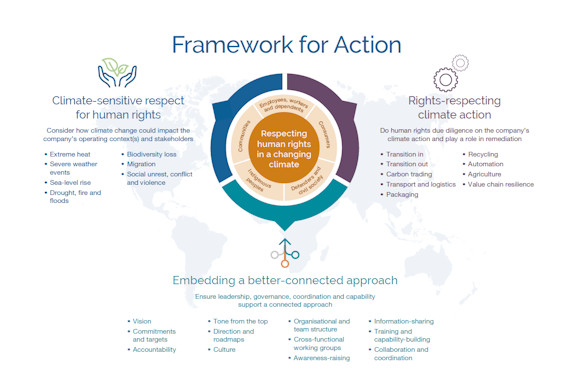Respecting human rights in a changing climate
It is now clear that a rapid transformation of our societies is needed to limit the worst impacts of the climate emergency.
Effecting this transformation will be a huge and challenging task. However, we need to aim higher, and do it in a way that leaves no one behind. That is, in a way that addresses the risks the transformation (as well as climate change itself) presents to people, with particular focus on those most at risk of vulnerability and marginalisation.
For businesses, this means respect for human rights should be a cornerstone of climate action. Further, the impact of climate change on businesses' operating context and stakeholders should inform human rights risk management.
Achieving both of these means finding practical and effective ways to better connect human rights and climate internally. Doing so may not be straightforward, and may raise many questions. But by taking proactive steps to embed a joined-up approach internally, businesses can help ensure that their response to climate change does not negatively impact at-risk communities, workers and other groups around the world.
Better connecting human rights and climate in practice
Consider how climate change is affecting the company's operating context and stakeholders:
- How will workers in agricultural supply chains be impacted by warmer temperatures, changing rainfall patterns and severe weather?
- What impact will extreme heat, fires, floods or other disasters have on workers' health, safety and aceess to essentials?
- How will communities be impacted by drought and water scarcity?
- How might climate-related migration and displacement affect migrant workers' risk of vulnerability or marginalisation?
Do human rights due diligence on climate actions:
- What steps is the company taking in connection with the energy transition (both transition 'in' and transition 'out')?
- Is the company engaging with carbon trading schemes that may impact human rights (for example, affecting forest or land use)?
- How might the transition to green transport, packaging and recycling affect the company's human rights risk landscape?
Ensure leadership, governance, coordination and capability support a better-connected approach:
- Find terminology that resonates across the business - for example, the language of 'resilience' or 'the doughnut model'.
- Ensure senior management understand the need for the people, planet and good governance dimensions of sustainability.
- Bring human rights and climate colleagues together to develop a shared vision and cross-fertilise knowledge.
What do the UN Guiding Principles tell us about better connecting human rights and climate change?
While not explicitly mentioning climate, the UN Guiding Principles on Business and Human Rights, or UNGPs, emphasise the need to respect human rights across all business activities.
Key guidance relevant to bringing a rights-respecting response to the climate crisis includes:
- Businesses should respect human rights. This means taking proactive steps to avoid negatively impacting human rights and addressing any negative impacts in which they are involved.
- Businesses should strive for coherence between their responsibility to respect human rights and policies and procedures that govern their wider business activities and relationships.
- Human rights due diligence should be initiated as early as possible in the development of a new activity or relationship. Assessments of human rights impacts should be undertaken at regular intervals, including prior to major decisions or changes in the operation, in response to changes in the operating environment and periodically throughout the life of an activity or relationship.
- In all contexts, business should treat the risk of causing or contributing to gross human rights impacts as a legal compliance issue.
See Guiding Principles 11, 16 - 18 and 23 for more.
Insights from our discussions
-
Get clear on what’s expected of business
There are authoritative global standards and emerging legal and regulatory requirements that set expectations of business as regards respecting human rights, managing environmental risks and issues, and contributing to solving the climate crisis.
While these expectations have developed somewhat independently over time, there is increasing convergence – reflected, for example, in emerging mandatory human rights and environmental reporting and due diligence requirements. This coupled with the UN General Assembly and UN Human Rights Council resolutions that the right to a healthy and sustainable environment is a universal human right create an impetus for business to manage environmental risks and respect human rights convergently. Importantly, across all areas, there is growing expectation that companies will take action that extends beyond the impacts of their own operations to risks and issues in company value chains.
There is value in getting clear on what’s expected of business across these areas, recognising that stakeholders increasingly expect to see companies adopt a coordinated and holistic approach to meeting expectations. Some business practitioners have observed that a coordinated response also presents opportunities to support more efficient and robust action, and to leverage progress in one area to support efforts to strengthen practice in another. -
Update your company’s human rights risk map
Mapping human rights risks at a high level is key to getting an overview of the company’s human rights risk landscape at a global level. Review your company’s human rights risk map and consider how climate change may affect its most salient - or severe - risks.
Does the company have operations in geographies that expect to experience drought, floods, fires or extreme heat - or that are likely to be affected by climate-related migration and displacement? Is it exiting or entering markets that may give rise to severe human rights risks? What human rights risks might arise in connection with other mitigation or adaptation activities?
If you company has not yet undertaken - or recently refreshed - a mapping of its key human rights risks, consider doing so, and ensure it encompasses human rights risks associated with climate change or the company’s climate action.
-
Ensure human rights due diligence encompasses climate-related decisions and action
Companies are taking a wide range of actions in response to climate change. Reducing emissions, increasing energy efficiency and setting net zero targets. Exiting fossil fuels and pivoting towards markets that support cleaner energy. Building resilience among farmers, workers, communities and others. And more.
Each of these actions is directed to achieving positive environmental outcomes and positioning the business to navigate changes to its operating context. But they can also have negative impacts on people. For example, renewable energy sources rely on transition minerals that are associated with poor and hazardous working conditions, forced and child labour and other human rights impacts. If not approached responsibly, the transition out of fossil fuels poses significant risks for dependent workers, communities and economies.
Conducting early human rights due diligence on these decisions will help your company identify and understand the risks to people – and create an opportunity for the company to take action to prevent or mitigate the harm. This requires internal coordination to ensure the need for human rights due diligence is identified and acted on. And collaboration with other stakeholders to work through the complexities and get input and feedback on the company’s proposed approach.
-
Prepare for a climate-related disaster
The changing climate has already resulted in a notable - and concerning - uptick in extreme weather events, floods, fires, droughts and other natural disasters.
Ensure your company is positioned to adopt a rights-respecting response in the event of a disaster. For example, build senior management’s understanding of the value of managing human rights risks in a disaster or crisis situation, and ensure that the company’s response and decision-making will be informed by human rights expertise.
See Crisis Management for more insights from business practice.
-
Anticipate and prepare for increased scrutiny from key stakeholders
Key stakeholders are increasingly expecting to see companies adopting a coherent and connected approach to thuman rights and climate.
For example, there is growing awareness among investors of the need to approach human rights and climate-related challenges holistically, drawing on systems thinking. As businesses themselves, investors are also subject to the same emerging regulatory requirements as the companies they invest in, which means that assessing the human rights and environmental impacts of lending and investment decisions is increasingly a matter of legal compliance.
Civil society is also now more focused on the connections between climate and human rights – and companies can expect stronger and better funded action from civil society organisations on just transitions and related movements. Alliances between investors, the media and civil society to focus on these issues are also becoming more common.
Finally, companies can expect to see the development of initiatives, such as benchmarks, that support customers, investors, civil society organisations and other stakeholders to assess companies’ commitments, practices and progress, while also providing a potential roadmap for companies.
-
A focus on just transitions is not an excuse to move slower on carbon
The just transitions concept is relevant to all businesses, regardless of sector. It encompasses the transition into cleaner energy, the transition out of fossil fuels, and a range of transitions relating to adaptation and resilience-building. Every business, community and country will need to transition.
Ensuring these transitions are made in a just way – that is, with respect for people – is key. And it’s complex. But that’s not an excuse to move slower on carbon. Rather, just transitions are a prerequisite to bringing people along. Net zero is a prequalification step – a premise to a just transition approach.
-
Embed a better connected approach
Increasingly, business practitioners recognise that a joined-up approach internally offers a dynamic and robust foundation for transition. Ensure the company’s leadership, governance frameworks, coordination mechanisms and capability support efforts to better connect human rights and climate.
Build commitment to a better connected approach among the company’s leadership, for example, by strengthening senior management’s knowledge of the links between human rights and climate, and the hardening expectations of business. Promote opportunities for clear internal messaging and ‘tone’ from the top’. Support a joined-up culture by familiarising colleagues with the ‘people’ dimension of sustainability, as well as the ‘planet’ dimension. Find and use terms that resonate - such as ‘resilience’ or ‘doughnut model’.
Align the company’s governance and culture, for example, by ensuring that lines of accountability enable connected oversight and decision-making. Look for opportunities to revisit team structures - for example, bringing human rights and climate specialists under a single manager with responsibility for both areas.
Finally, nurture connections and know-how to build capability and confidence working across human rights and climate where appropriate. For example, bring human rights and climate colleagues together for two-way familiarisation discussions to understand key concepts, expectations and terminology.
For more insights, watch recordings from our 2021 business dialogue: Business, human rights and the climate crisis.
Looking forward: Advancing connectedness
Ensuring a rights-respecting response to the climate crisis is key to achieving net zero in a way that leaves no one behind.
Places to start include:
Better understanding how climate-related actions impact people: A key challenge for business practitioners is understanding the human rights implications of the many decisions and actions being taken internally to respond to the climate crisis. And navigating situations where action that will achieve positive environmental outcomes is likely to result in human rights harms - or vice versa. There is an urgent need for multistakeholder collaboration to unpack the complexities of emerging responses by businesses and other stakeholders and to find rights-respecting ways forward.
Clarifying what is complicated - and what is not: Business and human rights and climate change are both vast and complicated topics. And for many business practitioners (and other stakeholders), the task of connecting the two can feel daunting. There are aspects of this work where it will be vital that business lean into complexity. But other aspects are more straightforward and already encompassed by expectations set out in the UN Guiding Principles (for example, the need to do human rights due diligence on climate action). By getting clearer on what is complicated and what is not, we can unblock efforts to more rapidly connect these two areas of work.




 Download, PDF
Download, PDF


